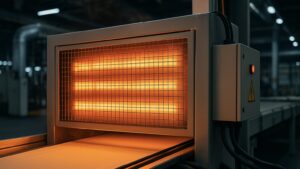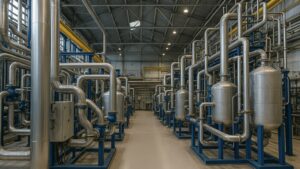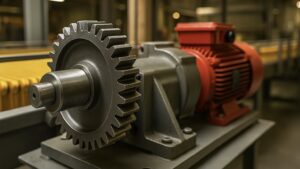Optimizing gigafactory layouts has become essential for guaranteeing smooth gigafactory operations and maximizing production in the battery manufacturing industry. These enormous facilities, devoted to producing lithium-ion batteries on a never-before-seen scale, need careful planning and design. It helps to maximize productivity, reduce bottlenecks, and satisfy the growing demand for energy storage solutions.
This article explores realistic tactics and industry best practices for maximizing gigafactory design and facilitating smooth gigafactory operations. So, let’s get started.
Understanding the Gigafactory Production Process
The efficient design of a gigafactory depends on a thorough comprehension of the complex production process of lithium-ion battery manufacture. Every process step has its own set of difficulties and chances for improvement. So, let’s see them:
Electrode Preparation
The binders and conductive additives combine with the active materials for the cathode and anode. It forms a slurry during the electrode preparation step. Furthermore, one creates the electrodes by coating tiny metal foils with this slurry, drying them, and then compressing them. Moreover, proper material flow and organization are essential at this stage. It guarantees constant quality and avoids contamination.
The electrode preparation area’s architecture is made with minimal material handling. It also has maximum throughput in mind. The equipment for mixing, coating, drying, and compression is then arranged logically. It minimizes the distance that materials and components must travel. Furthermore, automated guided vehicles and robotic handling systems improve and expedite the process.
Cell Assembly
At the cell construction stage, workers create individual battery cells by combining prepared electrodes with separators and electrolytes in a well-regulated setting. It helps to guard against contamination and guarantees constant quality.
The structure of the cell assembly space must take worker ergonomics, material flow, and environmental controls into careful account. Clean room settings with suitable air filtration and pressure control systems are crucial. It maintains the necessary degree of cleanliness. Additionally, the design minimizes needless handling and transportation while promoting a fluid flow of materials and components.
Optimizing material flow and lowering inventory levels may be achieved by implementing lean manufacturing concepts. It includes kanban systems and just-in-time supply, into practice. Ergonomic workplace design is also essential for promoting worker comfort and safety.
Formation and Testing
The cells are charged and discharged throughout the manufacturing process. It follows assembly, to ensure optimal performance. To ensure that the cells fulfill strict quality and performance criteria, they undergo extensive testing.
Effective material handling, quality assurance, and traceability are given top priority in the design of the forming and testing facilities. Putting in place automated processes for sorting and testing can greatly increase throughput. It can also lower the possibility of human mistakes. Moreover, processes downstream can be streamlined and possible problems can be eliminated. This is by properly organizing and segregating cells according to their quality and performance characteristics.
Optimizing Gigafactory Layout for Smooth Gigafactory Operations
If you are wondering how do you optimize a factory layout, a comprehensive approach to layout optimization is necessary. It helps to achieve smooth gigafactory operations. Moreover, it takes into consideration several variables. This includes material handling, process flow, flexibility, and scalability. Let us dive deeper into the elements for a smooth operation.
Process Flow Analysis
Optimizing the gigafactory plan starts with a detailed investigation of the manufacturing process. This entails laying out the complete workflow, from the receipt of raw materials to the transportation of the final product. It also includes locating any possible bottlenecks, inefficiencies, and places that may need improvement.
Process flow analysis is dissecting the production process into its components. It examines the flow of work and locates areas that may be optimized and streamlined. This might entail moving workstations or equipment around, and using parallel processing to increase throughput.
Manufacturers can find locations where materials or components are handled, stored, or transported needlessly. This can result in inefficiencies and quality problems, by visualizing and analyzing the process flow. The layout design may be informed by this study. So, it guarantees a seamless and effective flow of components and materials throughout the production process.
Modular and Flexible Design
Gigafactories must use a modular and adaptable design approach. With this method, the facility may easily reconfigure and scale in response to changing production requirements. It can also cater to changing product lines, or technology improvements without experiencing significant interruptions.
A modular design involves splitting up the building into independent sections, or modules. It should each be in charge of a certain set of tasks or procedures. Furthermore, the facility’s general operation remains unaffected by the simple addition, removal, or rearrangement of these components. The modular method offers enhanced flexibility and streamlines maintenance and upgrades. This is by enabling the isolation and modification of individual modules without causing any disruption to the production line.
The ability to accept future facility growth or reduction is another aspect of architectural flexibility. Gigafactories are designed with extensible floor layouts, flexible utility systems, and scalable infrastructure. It allows them to adjust to changing market conditions or output levels. This is without requiring major building or remodeling work.
Minimizing Material Handling
One of the most important tactics for gigafactory layout optimization is to minimize material handling. Overhandling materials raises the possibility of contamination or damage. Moreover, it also causes inefficiencies, longer lead times, and increased operating expenses.
Manufacturers may minimize needless handling and transportation by reducing the distance. This is one where materials and components travel by carefully placing workstations, equipment, and storage locations. Techniques like cellular layout and linear layout can be put to use to accomplish this.
It is also possible to reduce material handling and increase efficiency by putting in place point-of-use delivery systems. It sends components and materials straight to the point of use.
Optimizing Material Flow
Improving the flow of materials throughout the gigafactory is essential. It guarantees a seamless and effective manufacturing process. Moreover, lean manufacturing techniques, such as just-in-time delivery or kanban systems, can be put to use to accomplish this.
Just-in-time delivery minimizes the requirement for excess inventory. Furthermore, it lowers the risk of obsolescence or waste. It also synchronizes the arrival of supplies and components with the production schedule. On the other hand, kanban systems depend on visual cues to initiate material replenishment or transfer. As a result, it guarantees a constant and efficient flow throughout the manufacturing process. This is one of the most effective ways to optimize factory layout.
Implementing Automation
Using automated technologies is one of the best methods to maximize material handling and transportation. Moreover, productivity can potentially be increased by automated methods. Additionally, it reduces labor expenses and enhances process precision and consistency.
Automated guided vehicles are widely used in gigafactories. It moves components and supplies between workstations and storage locations. These self-navigating cars may be programmed to optimize material flow and follow predetermined routes. So, this eliminates the need for manual material handling.
Additionally, robotics may be used in several production-related steps. It includes packaging, cell assembly, and electrode coating. Robotic systems enhance overall quality and productivity by providing constant performance. It also provides high accuracy and the capacity to function in dangerous or difficult conditions.
Systems for automated storage and retrieval (AS/RS) are an additional useful automation tool for gigafactories. These systems effectively handle the material and component retrieval and storage. It also lowers the requirement for human interaction and the possibility of mistakes or misplacing items.
Smooth Gigafactory Operations: Designing for Safety and Compliance
Prioritizing safety and compliance within the gigafactory setting is just as vital as optimizing the architecture for efficiency. Lithium-ion battery manufacture requires the handling of hazardous chemicals and processes. So, it calls for strict adherence to industry rules and safety precautions.
Gigafactories may reduce hazards, safeguard their workers, and guarantee local and international standards compliance by integrating safety and compliance issues into the layout design.
Adhering to Safety Regulations
A gigafactory’s layout needs to closely follow all applicable safety rules. It includes fire codes, emergency escape routes, and procedures for managing hazardous materials. So, this entails creating suitable fire suppression systems. It also includes designated spaces for the safe handling and storage of hazardous items and well-indicated evacuation routes. This is one of the necessary elements for smooth gigafactory operations.
Moreover, proper signage, access control, and training programs are crucial. It makes sure that employees are aware of possible dangers and adhere to safety rules. Adding safety features may further improve worker safety within the facility. This includes personal protective equipment (PPE) stations, protective barriers, and emergency stop buttons.
Following standards relevant to the industry should be a top priority during the layout design process. Organizations such as the Occupational Safety and Health Administration and the National Fire Protection Association have created these. Finding any safety concerns and fixing them before they worsen might be aided by routine audits and inspections.
Maintaining Clean Room Standards
Clean room conditions are necessary for several gigafactory activities. It helps to avoid contamination and guarantee constant product quality. The design should include dedicated clean room spaces with the proper air filtration and pressure control systems.
The permissible level of airborne particles determines the clean room classification. So, the higher classes call for stricter controls. The architecture should make it easier to divide cleanroom sections from other production zones. It should also provide airlocks and gowning facilities. It helps to maintain the required standards of cleanliness.
An effective layout design may help maximize the clean room’s airflow patterns. It can also reduce turbulence and guarantee uniform working conditions. This might entail arranging workstations and equipment deliberately to maximize laminar airflow and reduce disruptions.
Ergonomic Workstation Design
Ergonomics is essential to promoting worker comfort. It also promotes security and output in a gigafactory. Lower productivity, fatigue, and musculoskeletal issues can result from poor ergonomic design. This in turn affects the facility’s total output.
The design of workstations, material handling equipment, and tools must take ergonomic considerations into account. This should be done while optimizing the arrangement. This might entail adding elements that lessen physical strain and encourage appropriate body alignment. It includes ergonomic lifting assistance, anti-fatigue mats, and adjustable workstation heights.
Ergonomic evaluations and simulations can identify possible risk factors and implement suitable remedies. Offering ergonomic training and encouraging frequent stretching and exercise breaks can also achieve a safer and more productive workplace.
Smooth Gigafactory Operations: Leveraging Digital Technologies
Utilizing digital technology may greatly aid in smooth gigafactory operations. So, it can provide efficiency, optimization, and overall performance. These cutting-edge technologies provide strong instruments for process optimization and layout optimization.
Digital Twin and Simulation
Simulation software and digital twin technologies offer important new perspectives on smooth gigafactory operations. Manufacturers may model and analyze different situations, find possible problems, and test optimization ideas before putting them into practice by building virtual copies of the facility.
Digital twins generate a full digital picture of the physical facility. This is by integrating data from several sources. It includes sensor data, computer-aided design (CAD) models, and simulation results. Moreover, data-driven decision-making and continual improvement are made possible. This is by the ability to replicate manufacturing processes, material flows, and layout configurations using this digital copy.
The simulation software can further help in examining the effects of rearranging the layout, moving pieces of equipment, or altering the process. This is on things like throughput, material handling, or energy usage.
Internet of Things (IoT) and Data Analytics
Using data analytics and IoT technologies in gigafactories can give crucial insights. This is for streamlining processes and increasing productivity. Manufacturers may gather up-to-date information on energy usage. They can also gather information on equipment performance, and quality control measures, among other elements of the manufacturing process. This is by installing a network of sensors and linked devices across the facility.
Organizations can use advanced analytics tools and machine learning algorithms to analyze this data. It helps to find trends, anticipate maintenance requirements, and streamline procedures. Predictive maintenance algorithms, for instance, can identify early indicators of equipment breakdown. As a result, it facilitates proactive maintenance and cutting downtime.
Organizations may also utilize data analytics to optimize scheduling, inventory levels, and material flow. It helps to achieve a manufacturing process that is effective and seamless throughout the facility.
Augmented Reality (AR) and Virtual Reality (VR)
Virtual reality and augmented reality technology provide creative ways to improve worker productivity. They also improve training and remote support in gigafactories. These technologies that provide immersion can execute virtual instructions, interactive simulations, and real-time information overlays. These boost efficiency and lower mistake rates.
In the worker’s field of vision, augmented reality apps can provide contextual information. It includes maintenance guidelines, assembly instructions, or quality control checklists. So, there is less need for paper manuals or other paperwork when information can be accessed without using both hands.
VR simulations can be put to use for training. It allows employees to rehearse difficult activities or processes in a secure virtual setting before carrying them out in the real facility. So, this may shorten training duration and enhance skill development. It can also lower the possibility of mishaps or mistakes during practical operations.
Moreover, AR and VR may help with remote assistance and cooperation. This reduces downtime and improves problem-solving skills. This is by allowing specialists in other places to offer on-site staff real-time direction and support.
Conclusion
A gigafactory’s layout optimization is a complex problem that calls for a multidisciplinary approach. It combines process knowledge, technical know-how, and a thorough comprehension of the particular needs of battery production. By using the tactics outlined in this thorough article, gigafactories may streamline operations. They can also increase productivity and satisfy the steadily rising demand for lithium-ion batteries.
However, as the world continues its transition towards sustainable energy solutions, the role of gigafactories becomes increasingly crucial. Attending premier industry events such as The Global Summit on Gigafactory Design & Construction on 18-19 April 2024 in Berlin, Germany provides an invaluable opportunity to stay at the forefront of this rapidly evolving field. It provides deep case studies, sessions, and networking opportunities to stand ahead on fronts like smooth gigafactory operations, EPCM engagement, testing/validation, and more. So, make sure you register right away!





